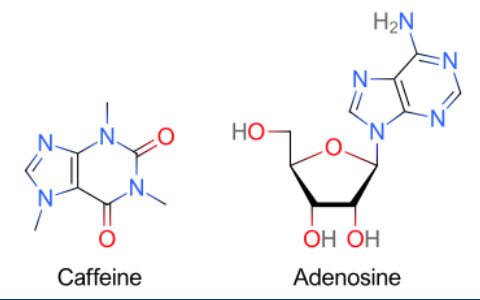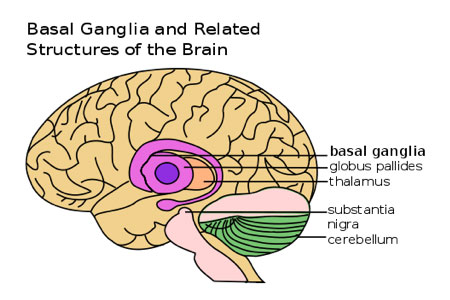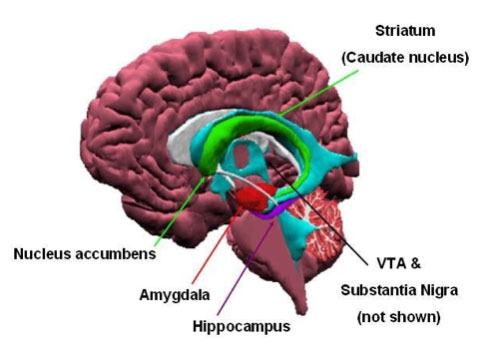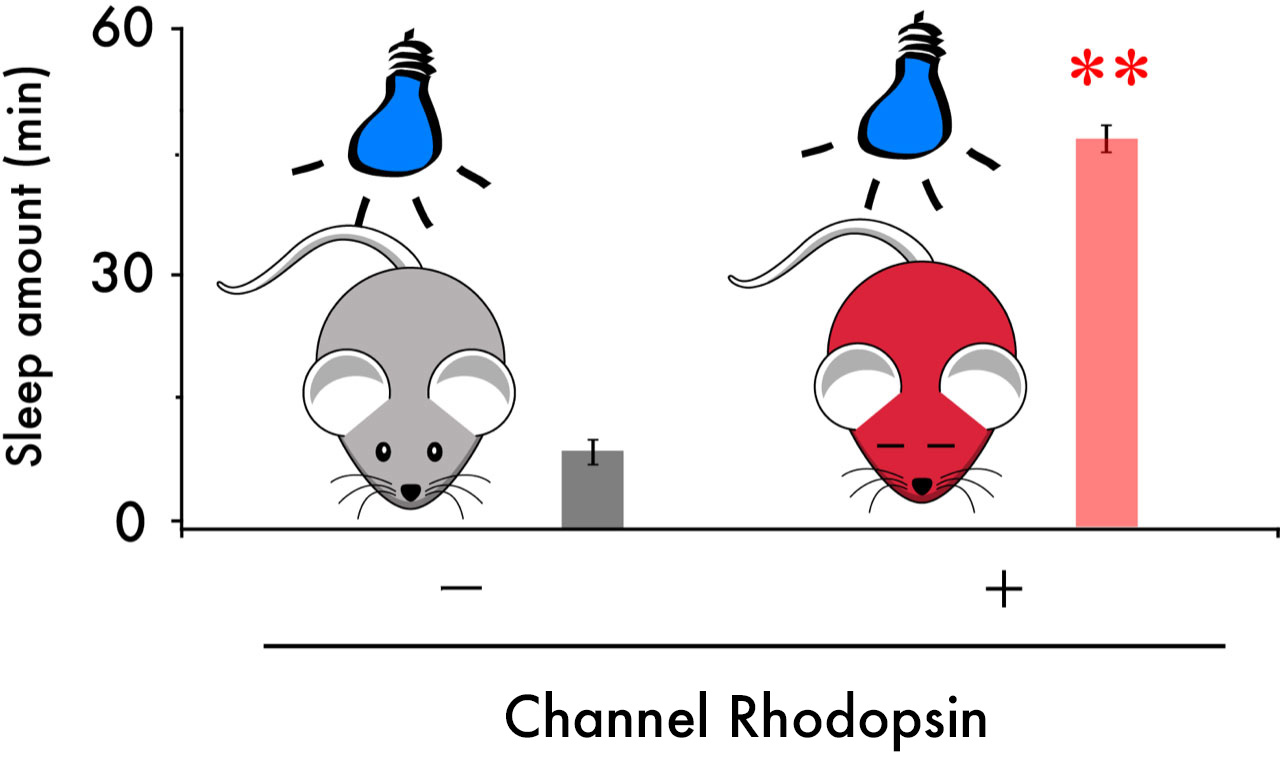How do you wake yourself up each morning? Perhaps you start the day with a cup of tea or coffee—or perhaps your parents do. According to the most recent statistics from the U.S. Food and Drug Administration, the average American consumes about 300 milligrams of
caffeine
per day—about three cups of coffee—and the average teenager consumes about 100
milligrams.
Clearly many Americans have found that caffeine helps them stay awake—but how? How is it that caffeine affects the brain? And what might this tell us about how we sleep? This month we highlight the work of sleep researchers who discovered how caffeine affects the brain, and who continue to use that information to piece together the mystery of human sleep.
Originally from Germany, Dr. Michael Lazarus received his Ph.D. in Biochemistry in his home country before moving to Japan to study with a famous Japanese scientist who had discovered several important enzymes. When he got to Japan, however, he learned that his mentor had changed fields from biochemistry to neuroscience, and so Dr. Lazarus did the same. Dr. Lazarus built his career in sleep science in Japan, then in the U.S., and then back in Japan where he joined the newly formed International Institute for Integrative Sleep Medicine at Tsukuba University in Tsukuba, Japan.
Caffeine and Adenosine
Dr. Lazarus’ research is focused on a substance called
adenosine.
Adenosine is one of the four so-called building blocks of life that make up all our genetic material, and the “A” in the energy-giving
adenosine triphosphate
or ATP involved in most cellular processes.

Figure 1. Molecular structure of caffeine and adenosine
[Source: https://en.wikipedia.org/wiki/]
Adenosine can also make you sleep when it binds to its
receptors
in the brain. Caffeine has a similar structure to adenosine (Figure 1). For this reason, caffeine can prevent sleepiness by binding to adenosine receptors instead of adenosine—thus blocking the function of adenosine and promoting wakefulness instead. However, this process was not well understood when Dr. Lazarus began his research into caffeine, adenosine, and sleep.
There are four different types of adenosine receptors in the body, called A1, A2A, A2B, and A3. Although all adenosine receptors bind adenosine, they differ in where they are found within the body and what systems in the body they act on. For example, while A1 receptors are found throughout the entire body, the other adenosine receptors are only found in certain locations, like specific brain regions. Previous work (Huang et al. 2005) identified caffeine as acting only on the A2A receptor.
Dr. Lazarus and his team wanted to know where in the body the A2A receptors that respond to caffeine were located. Given that sleep is regulated in the brain, the researchers focused on A2A receptors in different brain regions, specifically brain regions at the base of the brain known as the
basal ganglia,
because A2A receptors were known to be found in high concentrations there.

Figure 2. Picture of basal ganglia
[Source: https://en.wikipedia.org/wiki/Basal_ganglia#/media/File:Basal_Ganglia_and_Related_Structures.svg]
To focus on receptors in particular regions of the brain, the researchers had to be more specific than simply deleting the A2A receptor gene from the whole mouse. Instead, Dr. Lazarus and his team employed methods of selective gene deletion that used a virus to deliver altered genetic information to specific brain areas, selectively deleting the gene from those regions. All the mice with the A2A receptor gene deleted from different brain regions were then exposed to caffeine, and the researchers measured the effects of caffeine on wakefulness in the mice. This time, the caffeine was effective on all the mice except those without the A2A receptor gene in an area of the brain known as the
nucleus accumbens.
From these experiments, Dr. Lazarus concluded that caffeine promotes wakefulness by blocking adenosine from binding to A2A receptors located specifically in the nucleus accumbens.
The nucleus accumbens is located at the base of the forebrain, part of the basal ganglia. The basal ganglia are involved in controlling voluntary movements, decision-making, memory, and motivation, and the nucleus accumbens is best known for its role as the center for pleasure and reward.

Figure 3. Picture of nucleus accumbens.
[Source: https://tinyurl.com/yae5ngel]
When we do something pleasurable, like eating, this activates other areas of the basal ganglia which leads to an increase in production of the
neurotransmitter,
dopamine.
This increase in dopamine is responsible for feelings of pleasure. Although good sleep can often feel pleasurable, the nucleus accumbens was not known to be involved in sleep at the time Dr. Lazarus conducted these experiments. The findings from these experiments with caffeine led Dr. Lazarus to explore the role of the nucleus accumbens in sleep, challenging our understanding of sleep and sleep functions in the process.
The Sleep-Wake Cycle and the Nucleus Accumbens
There is a classical model of sleep that has been around for about a century that describes sleep as involving two processes, an S process and a C process. The S process is a regulatory or
homeostatic
process that involves something called sleep pressure that builds up over time. For example, when you first wake up, there is little pressure to go back to sleep, but as the day goes on and turns into night, sleep pressure continues to build until at some point you feel tired enough to go back to bed. The sleep pressure recedes as we sleep, and when we wake up the pressure is back at baseline. It builds again during the day and releases again at night--over and over for our entire lives.
The C process is a
biological clock
that controls the timing of our sleep. For example, the biological clock can be affected by light and dark, and by changes in time zones. If you travel across time zones and end up sleepy at odd times before you get adjusted, that is all due to the regulation of the biological clock.
Given his research into sleep and the nucleus accumbens, however, Dr. Lazarus believes there are some problems with this sleep model. The mechanisms of processes S and C are not well studied, and they don’t explain everything that can happen with sleep. For example, when you travel across time zones and feel sleepy because the C process is active, it’s not a given that you just fall asleep. It’s possible to override sleepiness through willpower. For example, if you have a conference that you must attend, or you really want to start sightseeing. Process C doesn’t account for your own decision-making and motivation. This is where Dr. Lazarus believes the nucleus accumbens comes in.
In his most recent set of experiments, Dr. Lazarus and Dr. Yo Oishi, a postdoctoral fellow in his laboratory, sought to understand how and under what conditions the nucleus accumbens regulates sleep. To do this, the researchers made small electrical channels in the skulls of mice and placed a wire into their neck muscles. They also applied a biological technique, called
optogenetics,
which uses genetically encoded proteins (channel rhodopsin) and light to control the activities of brain cells in the nucleus accumbens. This allowed the researchers to selectively excite neurons that express A2A adenosine receptors in the nucleus accumbens and measure the duration and quality of sleep.

Figure 4. Excitation of neurons in the nucleus accumbens drastically increases the amount of sleep.
The researchers found that they could induce sleep in the mice by exciting the A2A adenosine receptor neurons—the same neurons that caffeine acts on. When the researchers stopped artificially exciting the neurons, the mice would wake up. The researchers found that this process was not regulated by any sleep cycle like process S or C. Consequently, Dr. Lazarus believes he has found something which he calls a third sleep process that is independent of processes S and C, a process related to motivation, interest, and decision-making.
Here’s an example. Say you had a good night’s sleep last night. You went to school feeling refreshed and awake. Biology class was so interesting. You were learning about sleep and sleep cycles, you were focused on the material, taking good notes, and sleep was the furthest thing from your mind. But then that class ended, and you went to English class, where each student was giving their end-of-semester presentation. You weren’t interested in the material, you started to get bored, your eyes drooped, and all you wanted to do was lay your head down on the desk and take a nap. What happened? Did the sleep pressure from process S get to be too much and it was time for bed again? Probably not—it’s still morning! And as soon as English ends and you head to gym class, you’ll perk right back up. Was there something about your biological clock that was thrown off by English class? That, too, is unlikely. Today is no different from any other day as far as your biological clock is concerned.
So what is it about English class that’s making you sleepy? You know it intuitively—you got bored! You weren’t interested in the material, and the boredom put you to sleep. According to Dr. Lazarus, this is an important function of the nucleus accumbens. The nucleus accumbens is activated when you lose interest, putting you to sleep just as if some researchers were exciting your A2A receptors. When you regain interest and start using more brain power again, the excitement ends, and you regain your energy. In this sense, using your brain has a similar effect to caffeine—both prevent adenosine from binding to its receptors in the nucleus accumbens.
Now this is an interesting theoretical discussion—sleep processes and neuronal function would never put you to sleep. But there are important therapeutic implications to this research. If using caffeine to block adenosine from binding to its receptors can wake you up, then flooding the nucleus accumbens with adenosine to bind to A2A receptors could, in theory, help you go to sleep. And since good quality sleep is a large problem for many people, this could provide a safer, more natural alternative to the many sleep medications currently available at the pharmacy.
Consequently, future research in Dr. Lazarus’s lab will focus on using these findings to develop new sleep medications with fewer side effects. In addition, there is much more to learn about the nucleus accumbens and sleep. What activates the nucleus accumbens in the first place? Dr. Lazarus has some ideas, but he wants to prove them scientifically in the laboratory. Moreover, the effects of adenosine in the nucleus accumbens on other parts of the brain are very poorly studied, and Dr. Lazarus hopes to continue to study these pathways and connections.
Dr. Michael Lazarus is Associate Professor and Principal Investigator at the International Institute for Integrative Sleep Medicine at the University of Tsukuba in Japan. He is a biochemist and neuroscientist who studies the mechanisms of sleep in the brain. When not in the laboratory, Dr. Lazarus enjoys spending time with his family.
Dr. Yo Oishi is Assistant Professor at the International Institute for Integrative Sleep Medicine at the University of Tsukuba in Japan. He is a neuroanatomist and neurobiologist who is interested in how neural circuits control sleep or consciousness. When not in the laboratory, Dr. Oishi enjoys reading novels and watching movies.
For More Information:
- Oishi, Y., and M. Lazarus. 2017. “The control of sleep and wakefulness by mesolimbic dopamine systems.” Neuroscience Research, 118: 66-73, doi: 66-7310.1038/s41467-017-00781-4.
- Oishi, Y. et al. 2017. “Slow-wave sleep is controlled by a subset of nucleus accumbens core neurons in mice.” Nature Communications, 8: 734, doi:10.1038/s41467-017-00781-4.
- Saper, C., and P. Fuller. 2017. “Wake-sleep circuitry: an overview.” Current Opinion in Neurology, 44:186-192.
- Lazarus, M. et al. 2011. “Arousal effect of caffeine depends on adenosine A2A receptors in the shell of the nucleus accumbens.“ Journal of Neuroscience, 31(27): 10067-75.
- Huang, Z.-L. et al. 2005. “Adenosine A2A, but not A1, receptors mediate the arousal effect of caffeine.” Nat Neurosci 8, 858-59.
To Learn More:
- Lazarus Laboratory at the University of Tsukuba.
https://www.wpiiiislazaruslab.org/
- International Institute for Integrative Sleep Medicine.
https://wpi-iiis.tsukuba.ac.jp/
- National Sleep Foundation.
https://sleepfoundation.org/
- U.S. Centers for Disease Control and Prevention.
https://www.cdc.gov/sleep/index.html
- American Psychiatric Association.
https://www.psychiatry.org/patients-families/sleep-disorders/what-are-sleep-disorders
Written by Rebecca Kranz with Andrea Gwosdow, PhD at www.gwosdow.com

